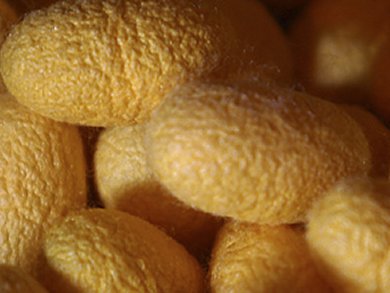Silk is made by unraveling — or unreeling — the fine, soft thread from cocoons of silkmoths. Most silk comes from cocoons of the domesticated Mulberry silkworm, Bombyx mori, a bred from a species native to Asia, because they are easy to unreel into long continuous strands. The cocoons formed by “wild” species are too tough for this process. Harsher methods have to be used which damage the strands, producing a poor-quality silk.
Fritz Vollrath and Tom Gheysens, University of Oxford, UK, and colleagues found that the surfaces of wild cocoons were coated with a mineral layer and that removing this layer made it easy to unreel the cocoons into long continuous strands with commercial reeling equipment.
In the Lasiocampid silkmoth Gonometa postica, the mineral is whewellite or calcium oxalate monohydrate. It is selectively removed by ethylenediaminetetraacetic acid (EDTA) leaving the gum substantially intact, preventing collapse and entanglement of the network of fibroin brins, enabling wet reeling. Mechanical testing shows that such preparation results in reeled silks with markedly improved breaking load and extension to break by avoiding the damage produced by the rather harsh degumming, carding or dry reeling methods currently in use.
This method, which clearly differs from the standard “degumming” and should be referred to as “demineralizing”, could expand the silk industry to new areas of the world where wild silkworms thrive like Africa and South America.
- Demineralization enables reeling of Wild Silkmoth cocoons,
Tom Gheysens, Andrew Collins, Suresh Kumar Raina, Fritz Vollrath, David P. Knight,
Biomacromolecules 2011.
DOI: 10.1021/bm2003362




